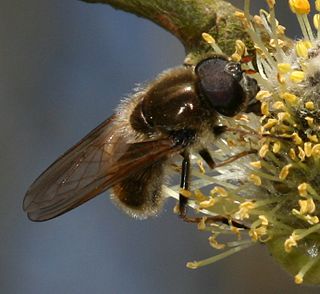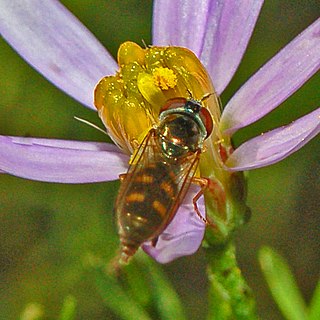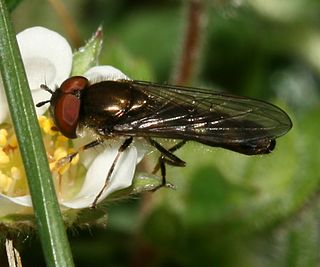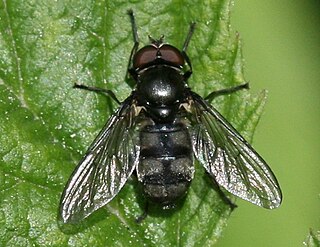
Hoverflies, also called flower flies or syrphids, make up the insect family Syrphidae. As their common name suggests, they are often seen hovering or nectaring at flowers; the adults of many species feed mainly on nectar and pollen, while the larvae (maggots) eat a wide range of foods. In some species, the larvae are saprotrophs, specifically detritivores, eating decaying plant and animal matter in the soil or in ponds and streams. In other species, the larvae are insectivores, preying on aphids, thrips, and other plant-sucking insects.

Eristalinae are one of the four subfamilies of the fly family Syrphidae, or hoverflies. A well-known species included in this subfamily is the dronefly, Eristalis tenax.

Eristalinus taeniops is a species of hoverfly, also known as the band-eyed drone fly.

Cheilosia albipila is a European and Palearctic species of hoverfly. Like most Cheilosia it is black, and because of this may often be overlooked as a hoverfly. It is little recorded but probably widespread and common and maybe overlooked because adult flight periods are early in the year, before many hoverfly recorders are active.

Dasysyrphus venustus is a Holarctic species of hoverfly.

Platycheirus scambus is a species of hoverfly. It is a Holarctic species.

Parasyrphus punctulatus is a Palearctic species of hoverfly.

Platycheirus scutatus is a very common species of hoverfly. It is a Holarctic species.

Platycheirus albimanus is a common widespread species of hoverfly. A holarctic species its range includes Greenland, Iceland, Britain, mainland Europe, Russia, across Siberia to the pacific coast, the Philippines, Alaska, western Canada and United States.

Syrphus torvus, the Hairy-eyed Flower Fly, is a common species of hoverfly found in the Holarctic. The adults feed on pollen and nectar, but the larvae feed on aphids.

Portevinia maculata, also known as the ramsons hoverfly, is a European species of hoverfly. The adults can be found around Allium species when the plants are in flower (May–June). The larvae tunnel through and overwinter in the bulbs of this plant.

Sericomyia (Arctophila) superbiens is a Palearctic species of hoverfly. It is a bumblebee mimic.

Platycheirus ambiguus is a small widespread species of hoverfly found across the Palearctic from Ireland to Japan. A spring species found in flight in April and May, it visits spring-flowering trees and shrubs, e.g., Prunus spinosa in deciduous woodland and scrub.

Platycheirus melanopsis is a species of hoverfly. It is found from northern Europe across to eastern Siberia. The larva is described by Rotheray
Platycheirus nielseni is a Holarctic species of hoverfly.
Platycheirus perpallidus is a species of hoverfly. It is a Holarctic species.
Platycheirus podagratus is a species of hoverfly. It is found in the Holarctic.
Platycheirus ramsaerensis is a Palearctic species of hoverfly. It is found along the parts of northern Europe that face the Atlantic. It is a member of the Platycheirus clypeatus group

Dasysyrphus pinastri is a species of hoverfly found in Europe.

Sphegina elegans is a species of hoverfly.















